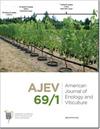Evaluation of Ripening Indicators for Harvest-time Decision Making in Cold Climate Grape Production
IF 1.8
3区 农林科学
Q3 BIOTECHNOLOGY & APPLIED MICROBIOLOGY
引用次数: 1
Abstract
Currently, growers and winemakers of cold climate interspecific hybrid grape (CCIHG) cultivars rely solely on the technological maturity variables Brix, titratable acidity (TA), and pH as ripening indicators for harvest and winemaking decisions. In contrast, using additional chemical variables to determine optimal harvest times is a common practice in most regions of the world where the European grape Vitis vinifera is cultivated. As there are significant differences in berry chemistry between CCIHG and V. vinifera, the objective of the present study was to evaluate, by linear regression coupled with principal component analysis and cluster analysis, the suitability of six additional maturity variables (berry fresh weight, total protein, total phenolics, monomeric anthocyanins, percent polymeric color, and total tannins) as potential ripening indicators for the CCIHG cultivars Brianna, Frontenac, La Crescent, Léon Millot, Maréchal Foch, Marquette, MN 1220, and Petite Pearl. We observed that berry fresh weight, total phenolics, and percent polymeric color had inconsistent and difficult-to-model relationships from year to year and across distinct grape cluster microclimate treatments, making them unsuitable as ripening indicators. In addition to the standard technological maturity variables of Brix, TA, and pH, the variables of total protein concentration for white cultivars and of monomeric anthocyanin, total protein, and total tannin concentrations for red cultivars have consistent linear relationships from veraison to harvest, making them good candidates for ripening indicators.寒冷气候葡萄生产成熟度指标的评价
目前,寒冷气候种间杂交葡萄(CCIHG)品种的种植者和酿酒师仅依靠技术成熟度变量白利度、可滴定酸度(TA)和pH作为成熟指标来决定收成和酿酒决策。相比之下,使用额外的化学变量来确定最佳收获时间是世界上大多数种植欧洲葡萄的地区的常见做法。由于CCIHG和葡萄果实的化学成分存在显著差异,本研究的目的是通过线性回归结合主成分分析和聚类分析,评价6个额外的成熟度变量(浆果鲜重、总蛋白质、总酚类、单体花青素、聚合物颜色百分比和总单宁)作为CCIHG品种Brianna、Frontenac、La Crescent、lsamon Millot, marsamchal Foch, Marquette, mn1220和Petite Pearl。我们观察到,浆果鲜重、总酚类物质和聚合物颜色百分比在不同年份和不同葡萄簇小气候处理之间存在不一致且难以建模的关系,因此它们不适合作为成熟指标。除了白度、TA和pH等标准技术成熟度变量外,白色品种的总蛋白浓度变量以及红色品种的单体花青素、总蛋白和总单宁浓度变量从品种到收获都具有一致的线性关系,使它们成为成熟指标的良好候选者。
本文章由计算机程序翻译,如有差异,请以英文原文为准。
求助全文
约1分钟内获得全文
求助全文
来源期刊

American Journal of Enology and Viticulture
农林科学-生物工程与应用微生物
CiteScore
3.80
自引率
10.50%
发文量
27
审稿时长
12-24 weeks
期刊介绍:
The American Journal of Enology and Viticulture (AJEV), published quarterly, is an official journal of the American Society for Enology and Viticulture (ASEV) and is the premier journal in the English language dedicated to scientific research on winemaking and grapegrowing. AJEV publishes full-length research papers, literature reviews, research notes, and technical briefs on various aspects of enology and viticulture, including wine chemistry, sensory science, process engineering, wine quality assessments, microbiology, methods development, plant pathogenesis, diseases and pests of grape, rootstock and clonal evaluation, effect of field practices, and grape genetics and breeding. All papers are peer reviewed, and authorship of papers is not limited to members of ASEV. The science editor, along with the viticulture, enology, and associate editors, are drawn from academic and research institutions worldwide and guide the content of the Journal.
 求助内容:
求助内容: 应助结果提醒方式:
应助结果提醒方式:


